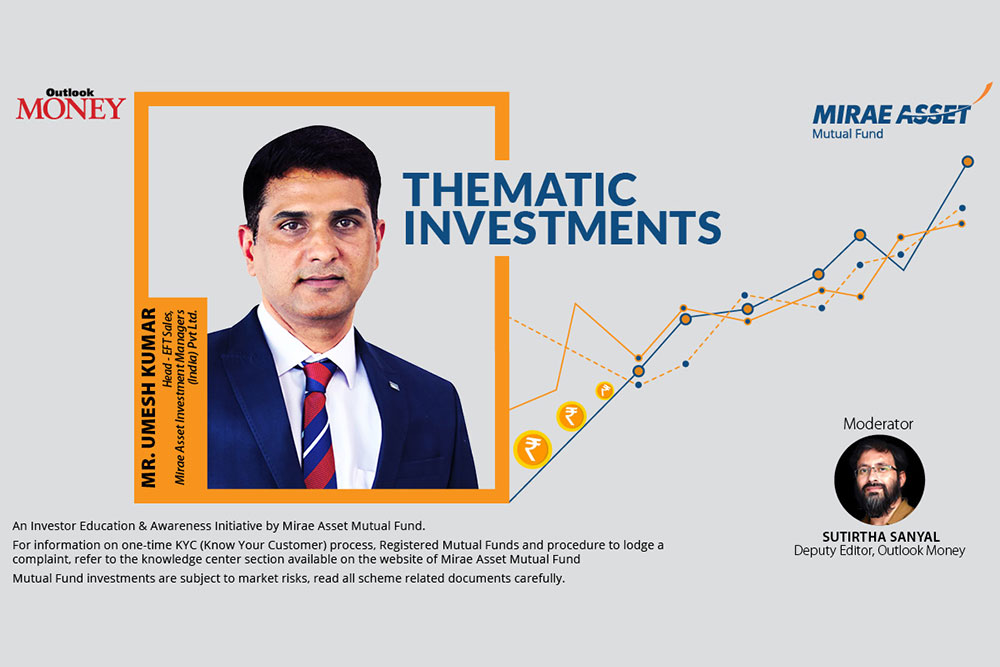Thematic investing has gained the attention of investors, of late. Amid the volatility in the stock market, the emerging trends in certain mega trends around electric vehicles, artificial intelligence have found favour with investors keen to explore these emerging futuristic themes. A recent discussion with Umesh Kumar Dalia, Head – ETF Sales, Mirae Asset Investment Managers (India) Pvt. Ltd as part of Outlook Money’s ‘Investment Made Easy’ webinar series threw some light on the strategy one should adopt for investing in thematic funds. Dalia was in conversation with Sutirtha Sanyal, Assistant Editor, Outlook Money.
Here are some edited excerpts from the discussion
What is thematic investing?
This is a type of investment strategy wherein you identify broad-based macro level trends in the economy, as well as the businesses that would be benefitted from such trends. It basically enables investors to get returns through potential opportunities created by economic, social or technological changes. This is a top-down approach to investment that uses macro-economic trends and identifies how to get profit from these investment avenues. Thematic funds represent a particular theme, and then keeping that theme in mind, invests in assets across businesses that represent that theme.
For instance, if you take manufacturing as a theme and want to invest in that theme, then the fund will invest into companies which are engaged in manufacturing in sectors like auto, pharma, chemicals, steel and etc. In essence, you are capturing the entire ecosystem starting from the beginning till the end.
So, all the industries that are part of the theme will become part of the investor’s portfolio if he chooses that theme. Thematic investing gives you exposure to all the industries that are involved in the entire ecosystem.
How have thematic funds grown in India and abroad?
A lot of investors have begun including themes in their portfolio. Data suggests that thematic investing is a global phenomenon, and where investors are globally looking for such avenues.
From an Indian perspective, in the last year, as of July 2022, 11 new products have already been launched in India and the current assets under management (AUM) of inflows is close to around 2,767 crore.
How are thematic funds different from sectoral funds?
The basic difference is their investment strategy. A thematic fund intends to capitalise on a trend, and would invest around a broad theme that cuts across different sectors. So, a theme could comprise multiple sectors also. For example, if we talk of the financial services industry as a theme, it would include banks, insurance companies, asset management companies, stock exchanges, and so on.
On the other hand, if we talk of a banking fund, then there you might find private or public sector banks.
Thematic funds basically cut across different sectors.
Are passive products a better way to invest in themes?
Passive funds are cost-effective, as compared to the actively managed funds. In case of thematic funds, they can allow for a lower price to participate in promising themes, which have structural tailwinds in the long run.
Many investors have a concern with the stock selection in a volatile market. In such a situation, indexing is a good method, as it allows investing in stocks which are already a part of the index.
What is the typical return expectation investors should look at?
Every product has a different return and risk profile. For instance, a thematic fund based on ESG might offer more stable return with lesser volatility than something like, say, robotics, which is expected to scale up in future in multi-fold over a longer period. It might generate higher returns also, but will be more volatile than a normal broad-based ESG kind of fund.
So, every fund has a different risk profile. Every investor should choose those funds keeping his/her own risk profile in mind.
What is the ideal allocation in terms of portfolio?
You should base this on your investment objective and conviction about that particular theme, and based on that, you can either take a short-term tactical call or make long-term strategic call. A long-term call will allow them to ride out the growth cycle of that particular theme, especially for a futuristic theme.
Since these themes have a higher concentration risk too, so, compared to broad-based indices, investors can consider 10-15 per cent allocation to these thematic products.
If an investor follows a core and satellite investment strategy, thematic funds can be a part of the satellite portfolio, while the broad-based funds would form the core.
Disclaimer
An Investor Education & Awareness Initiative by Mirae Asset Mutual Fund.
For information on one-time KYC (Know Your Customer) process, Registered Mutual Funds and procedure to lodge a complaint, refer to the knowledge center section available on the website of Mirae Asset Mutual Fund
Mutual Fund investments are subject to market risks, read all scheme related documents carefully.

